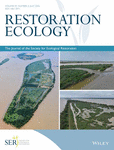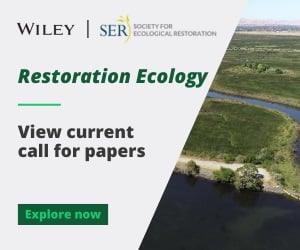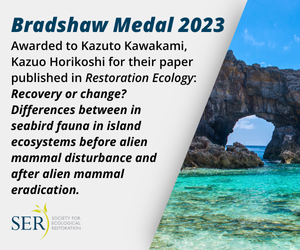Journal list menu
Export Citations
Download PDFs
ISSUE INFORMATION
RE-NEW OPINION ARTICLE
Evaluating the untapped potential of forest landscape restoration to streams
- First Published: 20 April 2025
OPINION ARTICLE
Overcoming barriers and leveraging opportunities to scale up landscape-scale restoration in Europe
- First Published: 21 April 2025
PRACTICE AND TECHNICAL ARTICLE
Vegetative multiplication of native Cerrado grasses for ecological restoration
- First Published: 02 April 2025
Animal releasing devices for deep-sea ecological studies
- First Published: 15 April 2025
Recovering kelp forests using newly constructed oyster reef restorations: adapting a kelp transplant method
- First Published: 02 May 2025
REVIEW ARTICLE
Endozoochorous seed dispersal by cattle—an option for species enrichment in deintensified grasslands?
- First Published: 07 April 2025
Human development and restoration-related public policies are positively related at the global level
- First Published: 21 May 2025
Currently 22% of policies include monitoring strategies. Without legal requirement to monitor, restoration is often considered successful—irrespective of its results. Given that adaptive management relies on continuous assessment, better monitoring mechanisms would enhance effectiveness and should be included in legal devices. Agroforestry appears in 7% of policies, in spite of their potential for reconciling agricultural production with biodiversity conservation and ecosystem service provision. Therefore, using indigenous mixed-species plantations should also be encouraged in public policies that consider agroforestry systems. Restoration success depends on enforcement, community involvement, as well as socioeconomic and cultural factors. Consequently, better conditions for human development may increase forest cover by restoration. Policies must integrate local contexts for effectiveness, while considering climate adaptation strategies.
Integrating the disconnected: enhancing wetland restoration by uniting invasive species management and native revegetation
- First Published: 16 June 2025
Effects of planting density on the performance of reforestation and afforestation plantings in temperate and boreal forests: a systematic review
- First Published: 09 June 2025
Higher planting densities can initially enhance stand yield and carbon sequestration while improving stem quality by limiting branchiness, but for longer-rotation plantations focused on timber quality, thinning is recommended. As plantations age, reduced individual-tree growth and quality, along with higher mortality, may require density reductions to meet management goals. Without better information, intermediate planting densities may help balance growth and stem quality without restricting individual performance. The strong demand for practical knowledge in Europe highlights the need for more local evidence, particularly on alternative performance indicators like physiological traits, tree health, and a range of biomass compartments.
RESEARCH ARTICLE
Salt tolerance as a factor in determining suitability of northern grasses for revegetation of oil sands sites affected by tailings release water
- First Published: 01 April 2025
Settlement and tidal zonation patterns of closely related oysters within the genus Saccostrea in a subtropical Australian estuary—implications for restoration
- First Published: 02 April 2025
Stream restoration effectively alters functional diversity and composition of riparian plant communities in the southern Rocky Mountains, U.S.A.
- First Published: 04 April 2025
Low genetic differentiation across restored and natural populations shortly after a large-scale, post-fire seeding in the Great Basin
- First Published: 02 April 2025
Restoration thinning promotes resprouting and recruitment in an Australian floodplain forest
- First Published: 06 April 2025
Threshold of lugworm (Arenicola marina) densities for successful transplantation of eelgrass (Zostera marina)
- First Published: 02 April 2025
Defining species-specific seed sourcing strategies for restoration: an example of how to use genetic data to inform seed collections for multiple co-occurring species
- First Published: 21 April 2025
Recovery of soil characteristics and soil invertebrate communities following wet meadow restoration
- First Published: 21 April 2025
Sentinel site networks as a mechanism to evaluate progress toward meeting restoration goals in altered and unaltered landscapes
- First Published: 07 April 2025
Fish use of restored shellfish reefs extends beyond the reef edge
- First Published: 17 April 2025
Changes in ground-layer plant species assemblages and successional patterns following a decade of oak regeneration restoration
- First Published: 17 April 2025
A global analysis of strengths and weaknesses in our scientific knowledge of tropical forest restoration
- First Published: 16 April 2025
Does wetland restoration create an ecological trap for migrating Brown trout smolts?
- First Published: 15 April 2025
Aquatic food webs in restored marshes: a stable-isotope approach in the Gironde estuary (SW France)
- First Published: 21 April 2025
Effects of European green crabs (Carcinus maenas) on transplanted Eelgrass (Zostera marina): potential protective measures
- First Published: 21 April 2025
Evaluating the suitability of reference sites to gauge the success of ecological restoration on arbuscular mycorrhizal fungal abundance and community composition
- First Published: 28 April 2025
Effect of river and floodplain restoration and reconnection on aquatic macroinvertebrates: seasonal responses over time
- First Published: 22 April 2025
Monitoring the structure of restored forests and assessing aboveground carbon density through canopy metrics derived from digital aerial photogrammetry and LiDAR
- First Published: 02 May 2025
Comparative assessment of the soil restoration process by four abundant tree species in a humid subtropical post-mining area
- First Published: 25 April 2025
Enhancing the performance of native tree plantings in a seasonally dry mountain forest: the effects of elevation, irrigation and herbaceous cover
- First Published: 02 May 2025
Restoration of a marsh-upland ecotone specialist: the role of elevation, amendment, and facilitation
- First Published: 19 May 2025
This study provides several ways restoration practitioners can move forward with determining how to restore ecotonal species. Given the steep gradients in ecotones, we recommend conducting surveys of distributional limits of wild populations to first understand species tolerance limits. Restoration experiments manipulating physical conditions or neighbors can help determine what factors allow an ecotonal species to extend into stressful conditions. Facilitation may prove more effective than soil amendment at ameliorating stressful physical conditions at the edge of the physical tolerance limit of ecotonal species. Restoration of these species is possible with knowledge of their elevational distributions and the factors limiting their expansion.







